“I believe we are long overdue in honoring Eric Pearce,” says production manager and Parnelli Board Advisor Kent Black. “A lot of people can directly or indirectly trace themselves back to Eric and Showlites — in fact, a lot of people who have fallen off the ‘Showlites Apple Tree’ went on to have successful careers.”
Showlites and its various spin-offs over the years, including today’s Show Group Production Services (SGPS/ShowRig), has been headed by one of the most influential members of our industry. Pearce has been on the cutting edge of live event technology since the founding of Showlites in 1974. ”Showlites has had a phenomenal influence on the industry because of the many aspects it pioneered that are now industry standards,” says Clive Forrester of All Access Staging, who joined Showlites in 1975. “The company always had a technological edge.”
“Showlites was one of TMB’s first customers back in 1983 and, I am happy to say, we are still doing business 30 years later,” says Marshall Bissett, TMB president. “‘Eric University’ has produced many companies whom we talk to every day. The world of trussing, cabling, and control systems owes everything to Eric’s good ideas.” Just a few of the legends that came out of the organization include Dale “Opie” Skjerseth (production manager, Rolling Stones); Gary Mardling (Kish Rigging); Jennifer Davies (All Access); Mark Spring (production manager, Paul McCartney, George Michael); Toby Fleming (production manager, Tina Turner); Ed Wannebo (production manager, Kenny Chesney); Kieran Healy (LD, American Idol); Simon Miles (LD, Dancing with the Stars); among many others.
“All the individuals who passed through Eric’s companies have shaped the face of the current concert touring industry,” Forrester adds, estimating hundreds have gone through the organizations and went on to launch successful careers. “I have a bunch of his former employees that work for me here at All Access!” he laughs.
The Glare of the Lights
Pearce was born in working-class London in 1950. “I grew up in the London neighborhood of Islington, playing games in the streets and the houses that were bombed out during the war,” he says. “It was there I inherited my mother’s determination and willpower to keep going against all the odds, but, unfortunately, not my father’s brains,” he laughs. His father was a set carpenter at Pinewood Studios. (Years later he would build flight cases for Pearce the younger).
Those who have worked with him will appreciate this anecdote: When six, a misguided teacher thought that proper punishment for Pearce’s lack of attention was to make him clean up the classroom’s sizeable and cluttered cupboard. The precocious Pearce looked at the mash-up mess of books, pencils, chalk, crayons, and other accessories and saw an opportunity. He stripped it all bare and started from scratch, organizing the material according to size —smallest, thickest, largest. The teacher returned to unveil to him a shock of approval. “For the first time she seemed speechless,” he grins.
While he says he left school “semi-illiterate — I could read but not write,” he taught himself much over the years, naturally following the path of his parents, aunts, uncles, and their parents into London’s West End theatre industry. “I worked as a stagehand years before I was legally old enough to do so.” It was only a matter of time before he was drawn from the darkened world backstage to the glare of the lights.
With a partner, Pearce formed Keylites in 1968, and his first big West End show was a revival of Hair. When that partner left in the early 1970s, Pearce changed the name of the company to Showlites and expanded the operation to include full production services.
“It was 1975 in London, and one of my roommates suggested I apply for a job at Showlites Ltd,” says All Access’ Clive Forrester. Pearce hired him, and Forrester was there when Showlites started the idea properly packaging gear for the market — one of the first of many firsts. “Things got to the point of getting a little more sophisticated than just scaffolding, and we were doing lighting and doing innovative things such as using Socapex multi connectors on dimmers — something that the industry liked and started copying.”
Showlites, in conjunction with its sister company, Alderham, devised a number of new goods, including the bar of six (bars of six par lamps using the Socapex multi-connector), the use of the multicore cable (instead of tape bundled cables) , the Alderham 602, a 60-channel lighting board, and the Alderham 804, an 80-channel lighting console, which Forrester says was the first veritable large rock ‘n’ roll lighting board. “These innovations revolutionized the concert touring industry in efficiency and ingenuity.”
Lighting designers were restricted to the limited capacity of control consoles of the day. “Decks with two rows of faders were state-of-the-art,” Pearce explains. “I brought together some young electronic experts from Oxford University’s theater arts division, and we created the Alderham Control Consoles and dimmer racks in the early 1970s.” Now designers had a third row of faders with innovative “flash buttons” that could allow the operator to instantly change to the beat of the music.
Forrester says that the multi-connector system and rapid deployment lamp bars were an especially big breakthrough. “We could speed things up with them, and when ABC saw us setting up a system for Elvis Costello at the Forum, they asked if they could rent our equipment for the American Music Awards. We said, sure — but the union was not happy about it, because they thought it would lead to less work.” The opposite proved to be true, as the device allowed designers to expand the size of their systems and hang more lights.
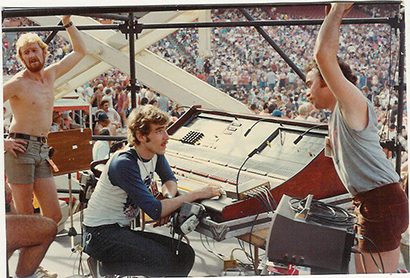
Dawning of an Industry
As rock ‘n’ roll shows grew bigger, they turned to the theater for gear. But that gear was not made for the road. Pearce laughs and says that once people realized the constant breakage was not the roadie’s fault but the gear itself, those who could not have imagined they were forging an entirely new market looked to improve the gear itself. “There were no rules about how to do things [that were] then new,” Pearce says. “You had to figure out how to make it happen. You would see what someone else was doing, then figure out how to improve on it and take it one step further.”
Showlites started supplying other production companies and quickly became known as purveyors of dependable gear. But that alone didn’t put the company on the map. Pearce paid attention to the less sexy details of touring and continued to come up with packaging systems that made transporting the gear safe and secure. His innovations in flight cases made him a popular resource for the equipment. Never mind that he built them in his parent’s second floor flat and would lower them over the balcony by rope to his Land Rover’s roof rack — you know, whatever it takes.
As dimming technology shifted from wire round resistors to solid-state devices, Pearce was putting more units in smaller, more reliable packages. Then he came up with the idea of one light per dimmer, which evolved into “hermaphrodite patching” of channels. Other innovations followed, including truss-based followspots, which he developed with Parnelli honoree Michael Tait, when Tait was designing for Yes.
His next big innovation was using PAR cans built from aluminum instead of steel, and shifted his focus to America, where new ideas seemed to be more readily welcomed.
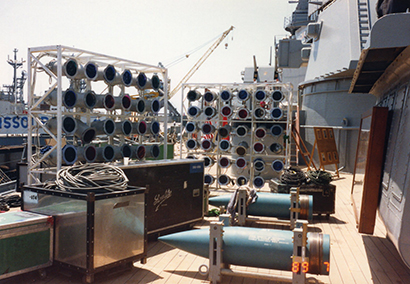
L.A. Bound
Showlites opened its North American office in Southern California in 1979, serving such acts as Van Halen, The Who and Supertramp. It supplied the Rolling Stones with lights, making them the first band to tour Europe with their own lights as well as sound. The company then opened an office in Dallas with an arrangement with Showco, then busy with Vari*Lite’s development. (Wannebo work out of that office.) Next came an office in Baltimore, which was a partnership with Maryland Sound, with Andrew Collins and Forrester running that operation (Eastland would be hired there shortly thereafter).
High-profile events added to their growing resume, included the inauguration of then-President Reagan, The Academy Awards, and the 1984 Olympics. Pearce continued to spin off companies including Showpower, Inc.
It was during the infamous 1,000-PAR can early Van Halen Tours that Pearce developed rapid deployment pods, the forerunner of scenic and lighting pods still used today. At this point the rugged, simple PAR can had replaced all theater lighting for touring. But now the race was on to come up with faster ways to put more lights in the air. Lamps were pre-attached to bars, allowing many to go up at a time. Then there was the cabling nightmare, to which Pearce responded with multi-core cables that quickly became the industry standard.
In the 1980s, Pearce further diversified beyond Showlites into Showstaging and Showfab. Bissett, who co-founded TMB in the early 1980s, first met Pearce in London years earlier. Showlites became an early TMB customer, as did “all of his ventures starting with the magic ‘show’ prefix. Eric has an uncanny knack of designing products that precisely fit productions. They are typically simple, elegant and easy to work with, and have a ‘Why did I not think of that?’ quality.”
Pearce would turn his problem-solving powers to trussing, with aluminum spigoted truss replacing older structural frameworks laboriously assembled from angled iron sections that resembled “power transmission towers.” Many of his innovations became industry standards.
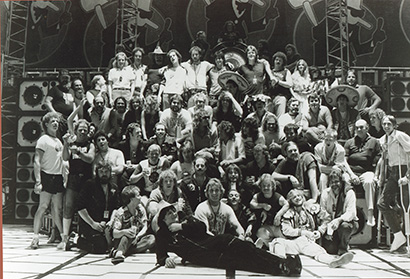
Industry Dominance
Showlites became a textbook example of how innovative thinking can help a young company gain a competitive edge. Showlites had been hired by The Who for the European tour leg, Pearces notes. While he was told in no uncertain terms by none other than Jack Calmes of Showco that Showlites “would not get the U.S. leg of the tour,” largely because Showco had ably handled the band’s U.S. tour leg previously, Showlites had one big advantage. Kieran Healy was the designer at the time, and he wanted the trussing system to be part of the visual look of the show; he was one of the first designers to take that approach. “Our new modular aluminum truss was able to do this. Showco would have had to custom-build the system, so we ended up getting the tour.”
Although competition for tours and gigs could get pretty intense, there were also opportunities for competitors to cooperate, too. Pearce’s first independent office had Obie’s and Zenith Lights as neighbors. “We were all competing for the same tours, while renting equipment back and forth to each other along the way.” Within a few years, Showlites outgrew those digs and moved to a 20,000 square foot warehouse down the road.
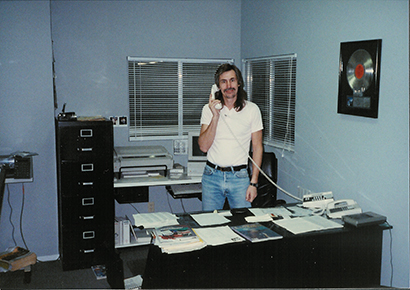
“In its best times, Showlites dominated the lighting industry and would operate up to 19 touring systems at once,” Forrester says. “To do this, we had a huge staff of constantly changing tour employees.”
Among the changles unleashed by Vari*Lites’ moving fixtures was “the end of the dominance of the PAR can,” Pearce smiles, adding: “Every dog has his day.” But he was not sold on the idea that one light could do it all, no matter how flexible it was, so he started looking at automating all kinds of light sources. By pairing a PAR can with a computer yoke, he created a bar of six PAR cans that could pan and tilt in unison. (It worked great once, apparently.) Though not a hit back then, the ideal of multiple lights moving around on a yoke has since taken hold with a new range of specialized fixtures.
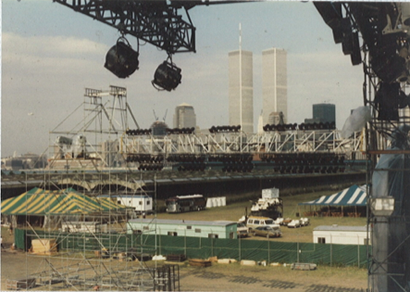
End of an Era?
In 1991, amid industry changes, Pearce put Showlites behind him. But after a short break in Florida, he returned to Los Angeles, concentrating on rigging and truss rentals. The company offered Single Track Truss and other products friendly to producers and union members.
In 2004, Pearce opened ShowRig in Las Vegas. “I realized that lots of companies could offer truss and motors, but we were there to offer better service,” he says. “Other companies weren’t putting enough emphasis on packaging and handling, and creating products that cut down labor time in loading and unloading and moving equipment down hotel corridors.” Another period of innovation ensued as ShowRig kept updating winch designs.
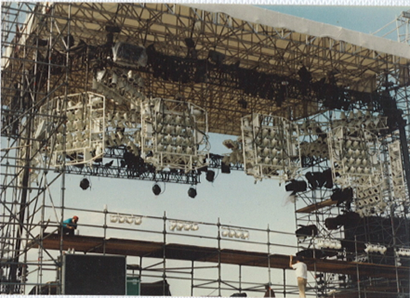
In 2008, ShowRig opened in Nashville. “With John ‘Hud’ Huddleston heading up the operation, we have slowly grown, and now have a small staff to support our country touring acts in a 20,0000 square foot facility,” Pearce says. With a steadily growing team of locally based touring personnel, “we can now truly be considered part of the local old boy network,” he adds. The New Orleans office opened in 2011.
“Eric has always been about making something cool,” Forrester says. “He loved to make things to the point that it was detrimental! He constantly made things, his philosophy being ‘why rent if I can build it?’”
“His success is attributable to his ability to provide fantastic consumer service,” Bissett says. “And he always had a great eye for filling in the gap and slots. He systemized things, always doing things better than anyone else.”

“Nothing was ever invented in a vacuum,” Pearce insists. “Many people being faced with the same challenges had the same idea at the same period in time.” But Pearce seemed to make it better, more dependable, and cooler than anyone, and his vision continues today.
“People always say to me, ‘why don’t you write a book about the early days of rock ‘n’ roll and tell the stories?’” Pearce adds. “Well I would, if I could only remember them!”
Eric Pearce will receive the Parnelli Visionary Award at the 2013 gala set to take place at the Las Vegas Mirage on Nov. 23. For more information and tickets, please visit www.parnelliawards.com.


